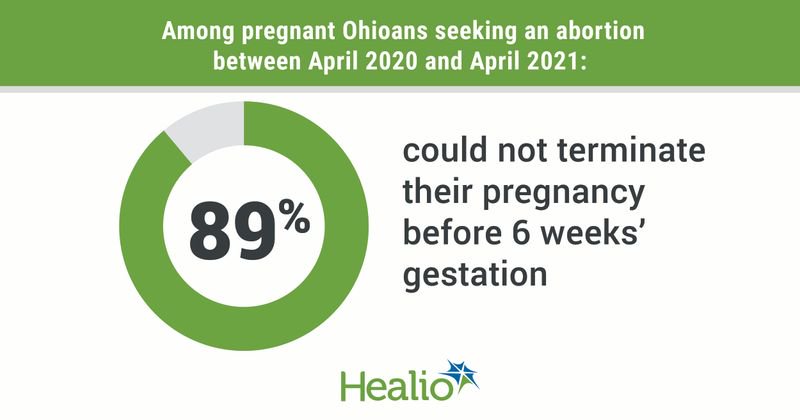Nine in 10 patients seeking abortion in Ohio cannot access in-state care legally
In Ohio, nearly all pregnant people seeking an abortion terminated their pregnancy later than 6 weeks’ gestation, according to data published in the American Journal of Obstetrics & Gynecology.
With the state’s current ban on abortions after 6 weeks’ gestation, this prevents most people from successfully and legally terminating their pregnancy.

“Regardless of when pregnancy is discovered, 6-week bans disrupt care for nearly all patients,” Abigail Norris Turner, PhD, a professor in the department of internal medicine at The Ohio State University, said in a press release. “Obviously, everyone who doesn’t know they’re pregnant until after 6 weeks’ gestation can’t get an abortion in our state. But when you also consider the requirement of at least two clinic visits, a mandatory 24-hour waiting period, staff shortages and high demand — among other factors — some people who know they are pregnant before 6 weeks are likely still not going to be able to get abortions before the 6-week limit.”
Norris Turner and colleagues conducted a survey of 1,141 people who sought abortions at seven Ohio clinics between April 2020 and April 2021. In survey responses, participants reported the date they discovered they were pregnant, the date they contacted the clinic and the date of and gestation at termination.
The researchers categorized participants as having discovered their pregnancy before 6 weeks’ gestation or after 6 weeks’ gestation.
Respondent characteristics
In total, 25% of participants discovered their pregnancy after 6 weeks. Compared with the rest of the study population, these participants were significantly more likely to have a lower income (P = .02) and be less educated (P = .05). They were also more likely to be younger, unmarried or Black compared with participants who discovered their pregnancy before 6 weeks’ gestation, although the differences were not significant.
Clinic contact, access to services
The median gestation at pregnancy discovery among all participants was 34 days, and the time between discovery and clinic contact was similar between participants who discovered they were pregnant before vs. after 6 weeks (3 days vs. 2 days).
However, those who discovered their pregnancy before 6 weeks’ gestation had significantly longer time to termination compared with participants who discovered their pregnancy after 6 weeks (22 days vs. 19 days; P < .01). Despite this, participants who discovered their pregnancy earlier completed their abortion significantly earlier compared with participants who discovered their pregnancy after 6 weeks’ gestation (median gestation, 53 days vs. 74 days; P < .01).
Nonetheless, 89% of abortions occurred after 6 weeks’ gestation.
“By examining abortion timelines with reference to pregnancy discovery, these findings provide important insights about the possible effects of 6-week abortion bans, although the data may not be generalizable to other states,” Norris Turner and colleagues wrote.
References:
- Study: Most Ohioans received abortion care after 6 weeks. https://www.eurekalert.org/news-releases/958891. Published July 14, 2022. Accessed July 21, 2022.
- Norris Turner A, et al. Am J Obstet Gynecol. 2022;doi:10.1016/j.ajog.2022.06.032.











